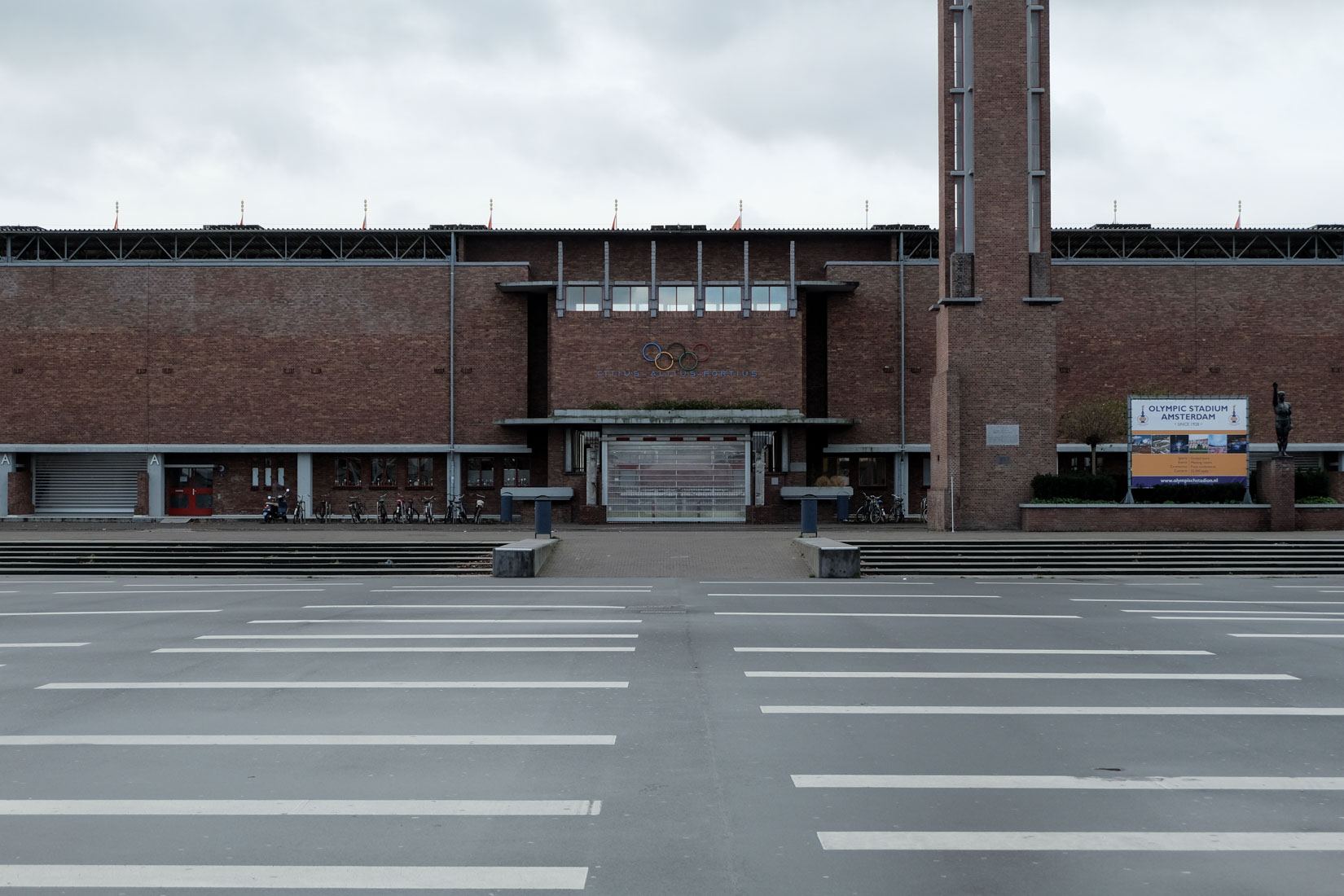 |
 |
 |
 |

Cornelis van Eestern - Netherlands
Gerrit Jonkheid - Netherlands
Olympic Stadium
Stadionplein, Amsterdam
1926 - 1928
The
Olympic Stadium in Amsterdam was built between 1926 and
1928 according to a design by the architects Jan
Wils, Cornelis van Eestern and Gerrit Jonkheid. The
stadium was built to mark the occasion of the Olympic
Games, which were held in Amsterdam in 1928. The
architectural design is mainly attributed to the architect
Jan Wils and shows the influence of Frank Lloyd Wright. In
the overall oeuvre of the busy architect Jan Wils, the
Olympic Stadium is considered the main work. With this
design, Jan Wils won the gold medal in the art competition
held on the occasion of the Olympic Games.
A slender tower marks the main entrance to the Amsterdam Olympic Stadium. It was on this tower that the Olympic flame was lit for the first time at the 1928 Games. This so-called Marathon Tower has a height of 42.19 metres, representing one thousandth of the marathon distance. The exterior of the stadium is characterised by the extensive use of exposed brickwork. The interior of the stadium is dominated by more modern materials and construction methods. This creates a clear contrast between the interior and exterior appearance. The pragmatic and efficient reinforced concrete skeleton construction is only expressed on the inside. The rows of seats are supported by a concrete structure. The roofs rest on steel lattice girders.
After the end of the Olympic Games, the stadium was a great asset for the Dutch capital Amsterdam. The structure was used intensively as an open-air arena for cycling races, football matches, ice hockey matches, but also for music festivals and the Queen's birthday. As interest declined, the stadium was increasingly left to decay. From 1996, it was restored at great expense by the architectural firm van Stigt. In the process, the grandstand extension from 1937 was dismantled and most of the building was restored to its original state.
A slender tower marks the main entrance to the Amsterdam Olympic Stadium. It was on this tower that the Olympic flame was lit for the first time at the 1928 Games. This so-called Marathon Tower has a height of 42.19 metres, representing one thousandth of the marathon distance. The exterior of the stadium is characterised by the extensive use of exposed brickwork. The interior of the stadium is dominated by more modern materials and construction methods. This creates a clear contrast between the interior and exterior appearance. The pragmatic and efficient reinforced concrete skeleton construction is only expressed on the inside. The rows of seats are supported by a concrete structure. The roofs rest on steel lattice girders.
After the end of the Olympic Games, the stadium was a great asset for the Dutch capital Amsterdam. The structure was used intensively as an open-air arena for cycling races, football matches, ice hockey matches, but also for music festivals and the Queen's birthday. As interest declined, the stadium was increasingly left to decay. From 1996, it was restored at great expense by the architectural firm van Stigt. In the process, the grandstand extension from 1937 was dismantled and most of the building was restored to its original state.
In
den Jahren 1926 - 1928 entstand das Olympiastadion in
Amsterdam nach einem Entwurf der Architekten Jan
Wils, Cornelis van Eestern und Gerrit Jonkheid. Das
Stadion wurde zum Anlass der Olympischen Spiele, die 1928
in Amsterdam stattfanden, erbaut. Die architektonische
Gestaltung wird mehrheitlich dem Architekten Jan Wils
zugeschrieben, und lässt den Einfluss von Frank Lloyd
Wright erkennen. Im Gesamtwerk des vielbeschäftigten
Architekten Jan Wils wird das Olympiastadion als Hauptwerk
betrachtet. Mit diesem Entwurf gewann Jan Wils bei dem
anlässlich der Olympischen Spiele durchgeführten
Kunstwettbewerb die Goldmedaille.
Ein
schlanker Turm markiert den Haupteingang zum
Olympiastadion Amsterdam. Auf diesem Turm loderte die
olympische Flamme, welche bei den Spielen 1928 zum ersten
Mal entzündet wurde. Dieser sogenannte Marathon Tower
weist eine Höhe von 42.19 Metern auf, und stellt dadurch
einen Tausendstel der Marathondistanz dar. Das Äussere des
Stadions wird von der grossflächigen Anwendung von
Sichtbacksteinmauerwerk geprägt. Im Inneren des Stadions
dominieren modernere Materialien und Konstruktionsweisen.
Dadurch entsteht ein deutlicher Kontrast zwischen dem
inneren und äusseren Erscheinungsbild. Die pragmatische
und effiziente Stahlbetonskelettbauweise kommt nur im
Inneren zum Ausdruck. Die Sitzreihen werden von einer
Betonkonstruktion getragen. Die Dächer ruhen auf
Stahlgitterträgern.
Nach
dem Ende der Olympischen Spiele war das Stadion ein
grosser Gewinn für die niederländische Hauptstadt
Amsterdam. Das Bauwerk wurde intensiv genutzt als
Freiluftarena für Radrennen, Fussballspiele,
Eishockeymatches, aber auch für Musikfestivals und den
Geburtstag der Königin. Mit dem rückläufigen Interesse
wurde das Stadion zunehmend der Verfall preisgegeben. Ab
1996 wurde es durch das Architekturbüro van Stigt mit
grossem Aufwand restauriert. Dabei wurde auch die
Tribünenerweiterung aus dem Jahr 1937 zurückgebaut, und
das Gebäude mehrheitlich in seinen Ursprungszustand
zurückversetzt.
